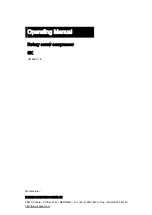
20 T-BA/ET-1250-0-GB-
10
-
11
7.0 Maintenance
Do not rinse the oil tank with solvent or
degreaser.
Do not forget to pre-lubricate (see „Prelubricate“ on
page 11.) before renewed use!
7.2.7 Check valve
Maintenance of the check valve is not required.
We recommend an initial inspection after 300 operat-
ing hours and then every 3 months.
Inspect the valve for oily carbon deposits and set the
date for the next inspection in accordance with the
appearance. The thickness of the oily carbon must not
exceed 1 mm.
Sealing and sliding surfaces must be free
from oily carbon deposits so as to ensure
the function of the check valve.
Where cleaning is required, the valve must be remo-
ved.
7.2.8 Vent valve
Fitment of the vent valve in an unfavourable position
may cause the bore for pressure compensation to
become blocked due to fouling which would restrict
the function of the vent valve.
To prevent this, inspect the vent valve regularly (at
least every 3 months, more frequently in the event of
considerable external fouling of the vent valve) and,
where necessary, disassemble the vent valve, remove
penetrating fouling and use compressed air so as to
clear the vent for pressure compensation.
7.2.9 Rotary slide valve rate of wear
Remove the vacuum filter, respectively intake pipe, so
as to be able to inspect the rate of wear of the rotary
slide valve.
Push the rotary slide valve into the rotary groove and
using a depth gauge measure the distance to the sur-
face of the rotor.
This dimension must not exceed 5 mm.
When the amount of wear has reached 5 mm, the
rotary slide valves must be replaced (see the separate
assembly instructions!).
The initial inspections should take place after about 6
months and should subsequently be repeated every 3
months (based on a daily operating time of 3-4 hours).







































